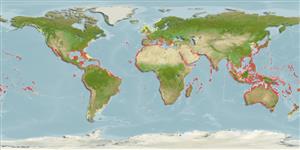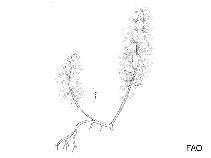Asparagopsis taxiformis (Delile) Trevisan de Saint-Léon, 1845
Red Sea plume| Native range | All suitable habitat | Point map | Year 2050 |

|
| This map was computer-generated and has not yet been reviewed. |
| Asparagopsis taxiformis AquaMaps Data sources: GBIF OBIS |
Upload your photos
Google image | No image available for this species;
drawing shows typical species in Bonnemaisoniaceae.
Google image | No image available for this species;
drawing shows typical species in Bonnemaisoniaceae.
Classification / Names Common names | Synonyms | CoL | ITIS | WoRMS
Florideophyceae | Bonnemaisoniales | Bonnemaisoniaceae
Environment: milieu / climate zone / depth range / distribution range Ecology
Sessile; brackish; depth range 0 - 22 m (Ref. 106682). Subtropical
Distribution Countries | FAO areas | Ecosystems | Occurrences | Introductions
Indo-Pacific, Atlantic Ocean and the Mediterranean.
Length at first maturity / Size / Weight / Age
Maturity: Lm ? range ? - ? cm
Short description Morphology
Thalli erect, greenish to red in colour, feathery or plumose, arising from a creeping stolon and attached by rhizoids to solid substrates. Central axis terete, bearing plumose branches at its upper 1/2 to 2/3 portion; the plumose branches are composed of numerous fine and delicate determinate branchlets which are densely disposed around an axis. Cystocarps subspherical or ovate, bright red in colour and borne at the apices of the short branchlets. Thalli up to 13 cm in height (Ref. 80758).
Used by humans as food and medicine (antibiotic and antimicrobial); used for animals as feeds; source of protein (Ref. 80758). Grows on solid substrates on reef or rocky shores exposed to moderately strong water movement (Ref. 80758). Also on mangrove prop roots, coral, rocks, or epiphytic up to a depth of 14 m (Ref. 83908). Gametophytes grow on rock faces and compacted sand and gravel (Ref. 89053).
Life cycle and mating behavior Maturity | Reproduction | Spawning | Eggs | Fecundity | Larvae
Main reference
References | Coordinator | Collaborators
Guiry, M.D. and G.M. Guiry. 2009. (Ref. 80701)
IUCN Red List Status (Ref. 130435)
CITES status (Ref. 108899)
Not Evaluated
CMS (Ref. 116361)
Not Evaluated
Threat to humans
Harmless (Ref. 80758)
Human uses
Fisheries: commercial
| FishSource |
Tools
More information
Internet sources
BHL | BOLD Systems | CISTI | DiscoverLife | FAO(Publication : search) | Fishipedia | GenBank (genome, nucleotide) | GloBI | Gomexsi | Google Books | Google Scholar | Google | PubMed | AlgaeBase | Tree of Life | Wikipedia (Go, Search) | Zoological Record
Estimates based on models
Preferred temperature
(Ref. 115969): 19.3 - 29.2, mean 27.7 (based on 5923 cells).



